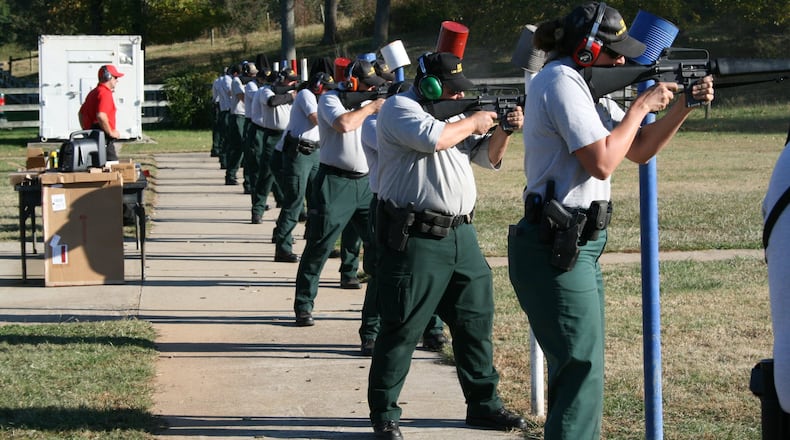For the first time, the federal government has released data allowing Americans to see what kind of military hardware is in the hands of their local police departments and government agencies.
In Georgia, the surplus military gear ranges from the harmless — an ice cream machine for the Department of Revenue — to deadly weapons from the field of war.
Here in metro Atlanta, the list of weapons and hardware includes:
- Two Humvees for the Fulton County Schools Police Department;
- Thirty M14 and M16 machine guns for the Clayton County Police Department;
- A grenade launcher for the Douglasville Police Department.
The full list includes dozens of up-armored vehicles, including mine-resistant military personnel carriers that look more like tanks than police vehicles. It also includes grenade launchers, dozens of bayonets, riot gear and more than 2,800 automatic rifles. The Atlanta Journal-Constitution has provided readers a searchable database of the gear at myAJC.com.
In all, state and local police departments and Georgia law enforcement agencies have received more than $70 million in decommissioned military gear, most of it coming in the last three years.
The release of the U.S. Defense Department's data comes amid heightened scrutiny of police tactics following the killing of an unarmed black man in Ferguson, Mo., and nationwide protests over his death. Police greeted the protesters in riot gear and armored vehicles and some members of Congress, including Rep. Hank Johnson, D-Ga., are calling for limits on the transfer of military weapons to local law enforcement agencies.
The Defense Department’s program, known as the 1033 Program, dates back to 1997 and has transferred more than $5.1 billion in surplus items to local law enforcement. Local departments get the items for free, except for shipping costs.
In the past, the Defense Department had disclosed much of the same data, but without information on which specific departments received the gear.
Robert Friedmann, a criminologist and director of the Georgia International Law Enforcement Exchange at Georgia State University, said there likely are excesses in the 1033 Program, but there are reasons for it, too. In America, police are constantly trying to keep pace with the firepower they face from criminals, he said.
“If you look at some other police departments and agencies in other countries, the United States is an exception,” he said. “There is nowhere in the world where you have so many police officers killed on duty.”
But some critics,including Occupy the Hood Atlanta organizer Russell Robertson, believe handing military equipment to local police creates more tension between law enforcement and civilians.
“That is the kind of equipment you use for a war. It’s not the kind of equipment you use to protect and serve,” said Robertson, a Cobb County resident.
Occupy the Hood Atlanta took part in demonstrations in downtown Atlanta this month. The protest was as part of wave of actions across the nation following the decision of a New York grand jury not to bring charges in the choking death of Eric Garner by a police officer.
Robertson said displays of military weapons and gear by local police only creates more hard feelings between cops and civilians.
“It brings anger up when you see the police come like that, it creates a sense of someone wanting to hurt you,” he said.
M16’s for tiny Dillard
As the United States’ military missions in Iraq and Afghanistan wind down, disposal of excess gear has picked up, and Georgia police departments have been willing recipients. Transfers to Georgia agencies went from $5.2 million in value in 2011 to $36.4 million so far this year.
The biggest ticket items are vehicles, including armored personnel carriers, Humvees, tractor trailers, and dump trucks. A survey of the data shows more than 500 vehicles worth nearly $40 million have been distributed, including a dozen mine-resistant vehicles.
Expensive military vehicles pushed the Carroll County Sheriff’s Office, which has nearly $7 million in former military gear, to the top of the state list.
“The person that we have overseeing that has been real aggressive looking at equipment that could be used to save taxpayer money,” explained Chief Deputy Brad Robinson.
Most of that $7 million in value came to Carroll County in the form of a fleet of used trucks, vans, tractor trailers, dump trucks, earth-movers and other forms of heavy equipment that would seem to have little use to a sheriff.
Robinson said the vehicles — such as four road scrapers and a crane — are in fact detailed to the county’s Public Works Department, although they remain on the sheriff’s books.
“We can’t permanently give it to someone, but it’s for their use over there, primarily for public safety,” he said.
While a number of districts have obtained vehicles through the military surplus program, the greater proliferation is in automatic weapons. Records show automatic rifles going to agencies in virtually every corner of the state. Last year, tiny Dillard, Ga., (population 198) got three of the weapons.
The Georgia Department of Natural Resources was one of the larger recipients of the military surplus items, including 210 M16 rifles and 208 long-range scopes, which the department’s officers use as their regular duty patrol rifle.
DNR Maj. Stephen Adams said outfitting conservation officers with automatic weapons makes sense when you consider that many of the people the officers encounter are armed with weapons that “shoot further and have greater knockdown power” than even the M16.
In addition, Adams said the DNR officers are often dispatched to assist other agencies in homeland security operations or in tracking down felons.
“As late as last Friday we were asked by the GBI to do a search in the mountains for an armed individual who had a kidnapped 14 year old,” he said.
Adams said DNR officers train two times a year with the weapons and do not carry them around unless the situations calls for it. Records show the DNR received the rifles over a period of years, with the largest shipment coming in 2010.
Before that, Adams said officers carried shotguns loaded with buckshot “with an effective range of about 40 yards.”
“This is something we have been looking at for a long time,” he said of the upgraded firepower.
Democrat proposes limits
But events in Ferguson have opened to debate the use of military weapons and equipment by police. In September, Rep. Johnson introduced the Stop Militarizing Law Enforcement Act. The bill, which has 48 co-sponsors, would greatly restrict the transfer of automatic weapons, armored vehicles and other items from the federal government to local police.
Johnson said he sees the use of military gear by police as part of a larger discussion of how police relate to civilian communities and minorities in particular.
“As crowds protest injustice that is a product of a dual justice system, then this issue of militarization fits within that,” he said. “It’s a broad discussion that we need to have about where we are headed in this country as far as civil rights are concerned.”
Democrats in the Georgia State Senate, where they are a distinct minority voice, announced in August their plan to push legislation prohibiting state and local law enforcement agencies from possessing military gear.
While the current debate centers on the behavior of police, GSU’s Friedmann said politicians are shirking responsibility for failing to address a culture of violent criminality in blighted communities.
“It is not just the responsibility of police. If you have blight in the neighborhood, do you expect the police to fix the blight?” he said. “It’s not up to the police to create jobs or make people understand there are different options to behavior other than crime.”
However, Friedmann said, the debate on some of the equipment in police hands has merit. Automatic weapons, for example, make little sense in most cases, he said.
“An M16 is an assault rifle. Why would you need that? Are you protecting the police station if it is attacked?” he said. “It’s legitimate to question the allocation methodology and to question the use, and especially, the training.”
About the Author
Keep Reading
The Latest
Featured



